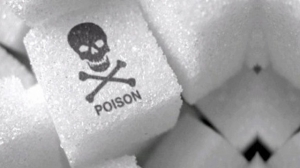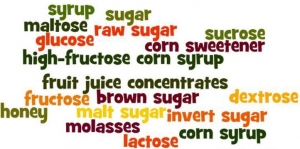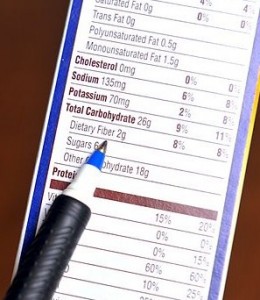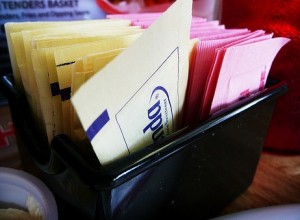 Welcome to week two of the Six Weeks to a Healthy Diet course.
Welcome to week two of the Six Weeks to a Healthy Diet course.
This week you’ll learn how to reduce sugar from your diet
Week 2 – Slashing the Sugar
In week 1, you learned about the importance of body composition measurements and why you should keep a food diary. Now let’s put those food diaries to work. This week is going to be all about reducing the amount of sugar you eat. By sugar, I am referring to processed sugars that you might see listed on a food label as sugar, high fructose corn syrup and sucrose. This also includes table sugar, turbinado sugar, brown sugar and even honey.
 Avoiding Sugary Snacks and Sodas
Avoiding Sugary Snacks and Sodas
This week you are going to work on eliminating the excess, or “added sugar” that is used in during the manufacturing of certain foods. You don’t need to avoid natural sugars like those found in fruits and some vegetables because those foods are good for you (in fact, next week you’ll start increasing your fruit and vegetables intake). The type of sugar I want you to eliminate is the added stuff that is present in a lot of processed foods and high-calorie sugary sodas and treats. It sounds easy, but sometimes you’ll need to read food labels to find hidden sugars.
Some sugary foods are obvious, such as sugar-coated cereals, sweet soft-drinks and bottles of syrup, but you’ll also find lots of sugar in healthier looking foods like instant flavored oatmeal, salad dressing, and cups of flavored yogurt. Even ketchup has sugar in it. When you’re shopping, look on the ingredients list for added sugar.
Sugar, Brown sugar, High fructose corn syrup, Corn sugar Syrup, Corn syrup, Fructose, Glucose, Sucrose, Raw sugar, Turbinado sugar, Honey
When you see these on the ingredients list of a packaged food, ask yourself a couple of questions.
Look at the Nutrition Facts label under “sugar” to see how many grams of sugar are in one serving. We’re going to calculate how many grams of sugar you should stick to each day—can the amount of the label fit in easily?
How much of this food will you eat?
You might drink a whole can of a sweetened drink, but only use a small amount of ketchup. Will you eat just one piece of chocolate or will you be tempted to eat the whole package?
Make smart decisions about foods that contain added sugar and put the package back on the shelf. Look for healthier versions without the added sugar or chose other items. Buy fresh fruit instead of candy and ice cream. Or if you really want a piece of chocolate, buy one, not a whole bag.
How Much Sugar Can I Have?
The World Health Organization suggests that no more than 10% of your daily calories come from added sugar. That’s a good goal. So let’s turn that into grams, so you can use Nutrient Facts Labels to track your sugar consumption.
Only 10% of that number of calories should come from added sugars. For example, if you need 1,600 calories per day, than only 160 calories should come from extra sugar. You can determine how many grams of sugar that is by dividing the number by 4 (there are 4 calories in one gram of sugar). So in our example, 160 calories would equal 40 grams of sugar.
If you don’t like calculating numbers or that seems like a drastic cut in sugar, then you can choose a different goal. Look at your food diary from last week. How many sugary foods did you eat or drink each day? Did you start most of your days with a sweet mocha latte from the coffee shop? How about switching to drip coffee or tea a few days each week? Once you meet these goals, you can set new ones.
Using Sugar as a Condiment
You don’t have to give up sugar completely – you can use sugar like a condiment instead of an ingredient. Each teaspoon of sugar has 16 calories or 4 grams of sugar. So instead of buying a pre-sweetened breakfast cereal with 15 grams of sugar in one serving, buy a whole grain cereal and add some fruit and sprinkle a little sugar on top. You’ll get your sweet flavor, but you’ll eat a lot less sugar.
You can use honey the same way. Nutritionally, honey is about the same as sugar, but since it adds more flavor, you may use a teaspoon of honey on some of your foods.
Using Artificial Sweeteners
Artificial sweeteners, which are also called “non-nutritive sweeteners,” add sweetness to many foods and beverages without adding any calories or nutrition. They are well-known ingredients in diet sodas and snacks, and some are easily identified in little colorful packets alongside sugar in your favorite coffee shop or restaurant. Common sweeteners include saccharin (Sweet’N Low), Sucralose (Splenda) and aspartame (Nutrasweet). Another non-caloric natural sweetener is an herb called stevia.
Some people find the use of artificial sweeteners to be controversial, although there is plenty of research that demonstrates the safety of these sweeteners. Some people object to the flavor of artificial sweeteners, which are different from natural sugars. If you don’t like artificial sweeteners, you don’t have to use them. If you like the non-nutritive sweeteners, just remember that while they don’t add calories to your diet, they really don’t add anything good either.
Tips for Reducing the Sugar in Your Diet
Buy fresh or frozen fruits and vegetables, whole grain breads and pasta, plain oatmeal, lean meats, poultry, fish, and dairy products. Avoid the overly processed foods and read the labels on packaged foods to look for added sugar. Buy plain yogurt and add a little bit of honey, some chopped nuts and lots of blueberries.
Serve fresh berries for dessert instead of ice cream. Make your own trail mix with dried fruit, mixed nuts and whole-grain cereal and take to work for a snack instead of candy bars, cookies or pastries.
Avoid ice cream sundaes, malts and shakes, and cold, blended coffee drinks, which are all high in sugar. Mix 100% fruit juice with iced green tea for a healthier drink.
Most of the fruit smoothies sold at coffee shops are filled with added sugar and not much fruit. Make your own smoothies at home with bananas, berries and a little non-fat milk.
Now that you’re going to pay more attention to the added sugar in your diet, choose a goal similar to one of these:
I will find new ways to cut the amount of sugary foods in my diet, by finding healthier substitutions
I will eat less than X number of grams of sugar three days this week (or four or five days). Calculate that number by using the example from the reading.
Continue to use your food diary. It will help you keep track of how you are progressing.
Your next lesson will help you incorporate more fruits and vegetables into your diet, even if you’re a picky eater – very important because fruits and vegetables are so good for your health. Next lesson Six Weeks to a Healthy Diet Week 3 Fruits and Veggies
Added Sugar Quiz
Ready to test your knowledge on added sugar? Take this quiz before moving on to lesson 3 next week.
1. Starch is made up of long chains of
a Aspartame
b. Broccoli
c. Sucrose
d. Glucose
2. What is another name for sucrose?
a. Table sugar
b. Nutrasweet
c. Honey
d. All of the above
3. Empty calories contain lots of fiber and minerals.
a. True
b. False
4. About 50% of your daily calories should come from carbohydrates?
a. True
b. False
5. Choose the food with the least added sugar per serving.
a. Flavored and sweetened yogurt
b. Chocolate ice cream
c. Plain oatmeal with blueberries
d. A can of root beer
6. Sucrose is made of:
a. Glucose and fiber
b. Glucose and fructose
c. Fructose and honey
d. None of the above
7. Which sweetener is an artificial non-nutritive sweetener?
a. High fructose corn syrup
b. Splenda
c. Turbinado
d. Glucose
8. Which one is an example of a food with added sugar?
a. Sugar frosted corn flakes
b. Plain yogurt topped with berries and nuts
c. A sliced orange
d. Whole-wheat pasta
9. Choose the healthiest source of carbohydrates.
a. Baked potato topped with salsa
b. Hot fudge malt
c. Glazed donut
d. Diet soda
10. Which substance is NOT a type of sugar?
a. Honey
b. Fructose
c. Sucrose
d. They are all types of sugar
Answers to added sugar quiz
1. Starch is made up of long chains of The correct answer is “d” Glucose
2. What is another name for sucrose? The correct answer is “a” table sugar
3. Empty calories contain lots of fiber and minerals. The correct answer is “b” False
4. About 50% of your daily calories should come from carbohydrates? The correct answer is “a” True
5. Choose the food with the least added sugar per serving. The correct answer is “c” Plain oatmeal with blueberries
6. Sucrose is made of: The correct answer is “b” Glucose and fructose
7. Which sweetener is an artificial non-nutritive sweetener? The correct answer is “b” Splenda
8. Which one is an example of a food with added sugar? The correct answer is “a” Sugar frosted corn flakes
9. Choose the healthiest source of carbohydrates. The correct answer is “a” Baked potato topped with salsa
10. Which substance is NOT a type of sugar? The correct answer is “d” They are all types of sugar







